UniFi U6-Pro and U6-Mesh Review and Speed Comparisons
Originally Posted: May 1st, 2022
Last Edited: July 20th, 2022
TL;DR:
The U6-Pro is my default recommendation for indoor UniFi Wi-Fi networks. It offers the best value and overall performance, especially with 5 GHz Wi-Fi 6 clients
The U6-Mesh is a Wi-Fi 6 update to the FlexHD, and is my default recommendation for outdoor UniFi networks.
For comparisons of all UniFi AP models, see my UniFi Comparison Charts and UniFi Access Point Buyers Guide.
All of my speed test chart images and results are available on Google Drive and Imgur as well.
Most product links are Amazon affiliate links, and listed MSRPs are in US dollars.
UniFi U6-Pro and U6-Mesh Review and Speed Comparisons
Last year I reviewed Ubiquiti’s first Wi-Fi 6 access points, the U6-Lite and U6-LR. Since then the U6-Pro and U6-Mesh have been released, and there are still a few more Wi-Fi 6 models in Early Access. My U6-Lite and U6-LR review also covered a lot of the basics of Wi-Fi 6, which I won’t repeat here. This review focuses on the specs and performance of the U6-Pro and U6-Mesh.
I’m including spec comparisons and iPerf speed test results from 13 different models of UniFi access points, as well as comparable models from Aruba Instant On and TP-Link Omada. We’ll start by looking at the specs of the U6-Pro and U6-Mesh and how they compare with UniFi’s other access point models.
Table of Contents
- U6-Lite vs. U6-LR vs. U6-Pro ↩︎
- AC-Mesh vs. AC-Mesh-Pro vs. U6-Mesh ↩︎
- Real World Differences ↩︎
- Single Client iPerf Speed Tests — 13 UniFi APs ↩︎
- Realistic Distance Speed Tests — 13 UniFi APs ↩︎
- UniFi vs. Instant On vs. Omada — Omnidirectional ↩︎
- UniFi vs. Instant On vs. Omada — Mesh and In-Wall ↩︎
- My Overall Thoughts on the U6-Pro and U6-Mesh ↩︎
The UniFi 6 LR (left), U6-Pro (middle), and U6-Lite (right).
U6-Lite vs. U6-LR vs. U6-Pro
Entry Level: U6-Lite
Spec comparison of the U6-Lite, U6-LR, and U6-Pro
The U6-Lite is the cheapest and least-powerful Wi-Fi 6 AP UniFi offers. It has the least range and performance, but it also has the lowest price and smallest size. It’s the same size (and uses the same mount) as the older AC-Lite and nanoHD. It is not dust or water resistant, and should only be used indoors.
The U6-Lite has an older 2.4 GHz radio, meaning it doesn’t deliver the benefits of Wi-Fi 6 for 2.4 GHz clients. The U6-Lite is an AX1500 class AP, with an 802.11n-era 2.4 GHz radio and a 5 GHz radio that tops out at 80 MHz channel width. The U6-Lite doesn’t support 160 MHz channels, unlike the U6-LR, Pro, and Mesh. They can all operate in DFS channels in the US, though.
After it was released, the U6-Lite had a hardware revision which lowered the maximum 5 GHz transmit power from 23 dBm to 17 dBm, further reducing 5 GHz range. It has since been changed back to the original 23 dBm TX power. I have one of the early production models before that change was made, but some hardware revisions will have the lower 17 dBm transmit power limit. Keep that in mind when viewing my test results below.
The U6-Lite is a good basic AP, especially in a multi-AP network, but it can’t compete with the range and performance offered by the other Wi-Fi 6 models. It’s the entry level option. Since Ubiquiti doesn’t drop the price on older models, it offers more value than the $99 AC-Lite or $99 AC-Mesh. It compares well with the $79 Wi-Fi 5 Aruba Instant On AP11, and trades blows with the $99 Omada EAP610.
Long Range: U6-LR
As the name implies, the U6-LR offers more range than the U6-Lite. The U6-LR has twice the spatial streams (2x2:2 vs. 4x4:4) in both bands, resulting in better beamforming and higher potential throughput. It is physically much larger, the same size as the AC-HD. The U6-LR is a step up in nearly every way, but it still has an older 802.11n-era 2.4 GHz radio and MediaTek chipset like the U6-Lite.
Before the U6-Pro was released, this was the undisputed high-end model. The U6-LR is still a good and powerful AP, but it’s place in the lineup isn’t as clear as it used to be. The U6-LR costs $179, which is $30 more than the U6-Pro. I’d argue the U6-Pro is a better buy, unless maximum range is more important than maximum throughput.
The unfortunate reality of long-range access points is that a lot of the time, the client you’re using is the limiting factor. Wi-Fi clients typically operate at lower power levels than the access point they connect to, resulting in asymmetric link rates and uneven performance at range. Most of the time, having more access points at a lower power level is better than having less access points at a higher power level. There are exceptions to any Wi-Fi rule, and there are plenty of places where the U6-LR is a good option.
Professional: U6-Pro
The U6-Pro is the newest of the three, and it is also a big step up from the U6-Lite. The U6-Pro also offers more transmit power, higher-gain antennas, more spatial streams, and more overall performance than the U6-Lite. The U6-LR and U6-Pro are both IP54-rated, meaning they are partially dust and splash resistant. They can be used in a protected outdoor area, like under a porch roof, but you wouldn’t want to install them in an unprotected outdoor area.
The U6-Pro switches from MediaTek to a Qualcomm chipset. Generally speaking, Qualcomm’s solutions are better than an equivalent MediaTek chipset. I’m glossing over a lot of details there, but the underlying differences are enough that Ubiquiti classifies the U6-Pro as a 6th generation device, while the U6-Lite and U6-LR are both 5th generation.
The U6-Pro is the same size as the AC-Pro, but fits into the same universal mounting bracket that Ubiquiti has used for years now. It matches or exceeds the U6-LR in most aspects, besides raw range. For $30 less, I think the U6-Pro is a better buy than the U6-LR. Things get a little more nuanced if you consider two U6-Lites vs. one of the larger models, but so much depends on the area you are trying to cover. In general, I think it makes sense to start planning an upgrade or a new UniFi network with the U6-Pro as the default option.
AC-Mesh vs. AC-Mesh-Pro vs. U6-Mesh
Entry Level: AC-Mesh
Spec comparison of the UniFi mesh access point models
The AC-Mesh is an AC1200 Wi-Fi 5 AP that is getting old, but it’s still for sale and a valid option for new outdoor installations. The AC-Mesh comes with removable omnidirectional antennas, which can be replaced with any antenna that has RP-SMA connectors. The AC-Mesh can operated on standard 802.3af (15W) PoE, or with Ubiquiti’s 24V passive PoE.
Ubiquiti also makes the UMA-D for $99, which is a more directional antenna for the AC-Mesh, meant for long-range coverage. The UMA-D offers 10 dBi of gain and 90 degrees of 2.4 GHz coverage, and 15 dBi of gain and 45 degrees of 5 GHz coverage. The AC-Mesh with the UMA-D is still a good solution for making the most of a single AP to cover a large outdoor area. Ubiquiti hasn’t made anything newer than can match the gain of an AC-Mesh + UMA-D, but the AC-Mesh-Pro comes closest.
Professional: AC-Mesh-Pro
The AC-Mesh-Pro is an AC1750 Wi-Fi 5 AP, offering more performance than the non-pro model. It doesn’t have removable antennas, but instead comes with high-gain (8 dBi) antennas built-in. The AC-Mesh-Pro is big enough that it could act as a lunch tray. It is harder to hide, but the additional antenna gain provide impressive range and performance. The AC-Mesh-Pro can operated on standard 802.3af (15W) PoE, or with Ubiquiti’s 48V passive PoE.
The AC-Mesh and AC-Mesh-Pro are still relevant, but are also due for an update. Ubiquiti hasn’t replaced these models with direct replacements, but they have made newer outdoor APs that can be considered instead.
Wi-Fi 6: U6-Mesh
As part of their AC Wave 2 lineup, the FlexHD offered a new enclosure, which resembles a tall, skinny Coke can. The FlexHD can be used on a shelf, mounted on a ceiling, or on a pole. The FlexHD can be used indoors or outdoors, and is generally a very _flexible_ access point. I’ve never had a FlexHD to test, but it should perform similar to a nanoHD, which I have tested.
The U6-Mesh takes the FlexHD’s enclosure and stuffs Wi-Fi 6 radios in it. It's a AX5400 Qualcomm-based AP like the U6-Pro. The U6-Mesh runs hot, but it also performs very well. It is IPX5 certified, meaning it can be used indoors or out, and mounted in the same way the FlexHD can be.
The U6-Mesh should be considered with the AC-Mesh, Mesh Pro, and FlexHD for new outdoor installations. The older models still have their place, especially in situations which require external antennas or extremely high gain. The U6-Mesh will have higher performance with Wi-Fi 6 clients, but the AC-Mesh + UMA-D would be better for maximum range. In most other situations the U6-Mesh wins out, and it is my default recommendation for outdoor UniFi Wi-Fi networks.
Real World Differences
It’s easy to list some specs and say “higher numbers are better!”, it’s harder to put those numbers in context. Swapping from one model to another changes things, but the biggest factor in Wi-Fi performance is the RF environment. Interference, obstructions, distance to your AP, the number of clients you have, and many other factors are just as important as the AP you pick.
I explained my current home network in Zen and the Art of Home Networking. In that post I walked through my home network and why I chose the APs and locations that I did. I’ve used the U6-Lite, U6-LR, U6-Pro, U6-Mesh, and several other models and vendors. The differences aren’t always what you would expect from the spec sheet.
In reality, a single U6-LR or U6-Pro can cover my entire house, at least with a usable 2.4 GHz signal. So why is my current network a UDM, U6-Pro, U6-Enterprise, and an AC-Mesh? For one, I'm a nerd and I like over-engineering things. I don’t need four access points to cover my house and yard, but by using more radios at lower power, I’m optimizing for maximum performance in every corner.
For those considering other vendors, the Aruba Instant On AP22 is very similar in price and performance to the U6-Pro, but the outdoor AP17 is overpriced for what you get. The Omada EAP610 offers more than the U6-Lite for $99, and the EAP660HD and upcoming EAP670 compete with the U6-LR and U6-Pro. The only outdoor Omada model I have is the Wi-Fi 5 EAP225 Outdoor, which is essentially a lower-priced AC-Mesh. The upcoming Wi-Fi 6 EAP610 Outdoor should be a better match for the U6-Mesh when it comes out this summer.
Asterisks and Grains of Salt
Wi-Fi performance is hard to accurately capture. Before we cover my iPerf results, it’s important to understand what they do and do not say. iPerf is a tool for testing throughput on wired and wireless networks, but it is easy to misinterpret these numbers, or put too much importance on them. Using a public speed test server like fast.com or speedtest.net will almost always result in lower speeds. iPerf is a good way to get repeatable results and test the upper end of performance, but they don’t always reflect normal everyday use.
iPerf tests are like taking a car to a drag strip and putting the accelerator on the floor. Most people don't commute on drag strips, and 99% of the time you're not going to be pushing an access point to it's throughput limit with a single client. Things that aren't captured in these results — roaming performance, multi-client throughput, latency, consistency, re-transmission rates — arguably matter more than how fast they can be in a straight line.
Wi-Fi equipment is marketed with maximum theoretical data rates, such as 1200 or 2400 Mbps. These numbers represent a speed limit, in a sense. You’ll never get 1200 Mbps of throughput from a 1200 Mbps data rate, because Wi-Fi is a shared medium with many sources of overhead.
As an example, every 1/10th of a second an AP sends out a beacon frame, which advertises the network to nearby clients. Beacon frames and other management traffic are typically sent out at the slowest data rate so all clients can accurately receive them. These messages consume a small fraction of airtime. In most networks other clients and nearby Wi-Fi devices are consuming airtime as well, and little chunks of time are wasting switching back and forth. All of these factors limit how much data can be sent or received by clients, and they will cause your results to be different from mine.
Things are more complicated now because of multi-user MIMO, OFDMA, and other factors, but Wi-Fi is traditionally half-duplex. This doesn’t mean throughput gets cut in half, it means that only one device can be transmitting on a channel at a given time. Wi-Fi is more like a walkie talkie than a phone call. If you have two devices in use, they have to take turns transmitting and receiving data. This results in small gaps in time where devices are waiting to make sure the coast is clear for them to transmit. Add in beacon frames, transmission errors, other sources of interference or delay, and getting 50-70% of your data rate is actually doing pretty well. In ideal conditions you’ll get closer, but data rates are like the speed of light — you’ll only achieve a fraction of it.
Basically, what I'm trying to show with these results is what each model can do, in an ideal scenario, at close range and at distance. Single client iPerf throughput results shouldn't be the only factor you consider when picking an AP.
iPerf Speed Tests — 13 UniFi APs
Close Range, best-case scenario
First, I tested close-range 2.4 GHz and 5 GHz performance. I used a standard 2x2 AX1200 Wi-Fi 6 client, a Windows desktop using an Intel AX210 Wi-Fi card. I used a local iPerf server, and wired gigabit Ethernet backhaul on every AP besides the BeaconHD, because it doesn’t have an Ethernet port. This is testing _best-case_ downlink capacity to a single client. I ran all of my tests using the following iPerf commands on my test client:
iperf -c 10.250.10.10 -P 8 -R -t 70 -O 10iperf -c 10.250.10.10 = Run a test as a client, the server IP address is 10.250.10.10
-P 8 = Use 8 parallel streams. Without parallel streams, the default TCP window and buffer size of iPerf doesn’t always saturate a fast wireless channel. To maintain consistency I ran all my tests with the default window and buffer sizes, with 8 parallel streams.
-R = This is downlink test, where the server is sending data to the wireless client. Without this flag, the client will send data to the server.
-t 70 -O 10 = Run this for 70 seconds, and omit the results from the first 10 seconds.
For more details consult the iPerf documentation.
I ran this 5 times, and averaged the results and rounded them to the nearest 0 or 5. This tests the ability of the iPerf server to send data to my wireless client as fast as it can. For most people, most of the time, download performance is the more important metric. Wi-Fi link rates are often asymmetric, and there’s a lot of variables I can’t account for. I did my best to keep an even playing field and use a clean channel, but my house is not an RF testing lab.
I ran these tests with 20, 40, and 80 MHz channel widths. I've also tested 160 MHz channels, which quickly run into the ~930 Mbps TCP throughput limit of a gigabit Ethernet connection, but perform worse at range. I'll cover 160 MHz channels and 2.5 Gbps Ethernet in more depth when the U6-Enterprise leaves early access.
I don’t recommend using 40 MHz channels in the 2.4 GHz band, due to them overlapping with over 80% of the already-crowded spectrum. There’s only one non-overlapping 40 MHz channel in North America, and the rest of the world only has two. Like 160 MHz channels in 5 GHz, there is not enough available frequency for them to be reliably used in most situations. Wider channels also impose a noise penalty, and are generally worse at range than narrower channels.
With these results and all the others below, I sorted the models by type and price. On the left are the mesh and In-wall models, followed by omnidirectional models. Cheaper models on the left, more expensive models on the right. All of these graphs come in 3 flavors: 2.4 GHz only, 5 GHz only, and combined results. All of the images are available on Google Drive and Imgur as well.
UniFi APs — Close Range Results
For my next test, I tested from 3 different places in my house. I wanted to show the impact of distance from your AP on a typical 20 MHz 2.4 GHz or 80 MHz 5 GHz channel. The above tests were very close range, and were meant to show an absolute best-case scenario. These distance tests are more realistic, and the 15 feet + 1 wall results are more likely what you will see in typical use.
With every foot of free space and every obstruction, a Wi-Fi signal attenuates and gets weaker. 5 GHz signals attenuate faster, and provide around half the range of 2.4 GHz. When deciding on how many access points you need, a good general rule is don’t expect 5 GHz coverage to extend further than 2 walls or 30 feet away. Some APs like the U6-LR extend this circle out a bit, but with the others APs, roaming to 2.4 GHz or getting low SNR 5 GHz performance is possible at the far edges.
When further away, you can see the impact of the lower transmit power for APs like the U6-Lite. Higher power and higher spatial stream APs offer more distance, and can compensate with features such as beamforming. Range is where the U6-LR and U6-Pro show their biggest advantage over the U6-Lite. Higher gain antennas and higher transmit power allow them to reach further. A few extra dBm is enough to allow an AP to effectively cover a larger area.
The difference between the U6-Lite and U6-LR is large enough that it could be the deciding factor between needing one or two APs to cover a given area. In some situations one U6-LR is better, in others two U6-Lites may be better. It’s hard to make general conclusions. There wouldn’t be much difference in performance or price, so that decision probably comes down to where you have Ethernet cabling more than anything.
Note for International Readers
5 feet = 1.5 meters
15 feet = 4.6 meters
30 feet = 9.1 meters
UniFi APs — Distance Results
For my next set of tests, I compared the U6-Pro to some similar models from Aruba Instant On and TP-Link Omada. These are all indoor models, which are good for broad coverage over a large area. I also sorted these by price, with cheaper models on the left.
Aruba Instant On AP11 ($99)
TP-Link Omada EAP610 ($99)
UniFI AC-Lite ($99)
UniFi U6-Lite ($99)
UniFi AC-Pro ($149)
UniFi U6-Pro ($149)
Aruba Instant On AP22 ($165)
Aruba Instant On AP15 ($179)
TP-Link Omada EAP660 HD ($179)
UniFi nanoHD ($179)
UniFi U6-LR ($179)
UniFi AC-HD ($349)
Omnidirectional APs — Close Range and Distance Results
I also ran the same tests on mesh and In-Wall access points from UniFi, Omada, and Instant On. The results are sorted by price, with mesh models on the left, and in-wall models on the right. Generally speaking, mesh models are ideal for outdoor Wi-Fi coverage. The BeaconHD is an outlier here, due to its lack of Ethernet and weatherproofing.
In-wall models are handy if you have Ethernet run to a wall plate. The three models I've tested aren't the best to compare because I don't have a AC-In-Wall-HD, or a Wi-Fi 5 model from Omada. Once again UniFi and Omada APs are generally the best value. The Instant On AP11D and AP17 are the worst value on a pure performance per dollar metric, but hopefully they'll be replaced with Wi-Fi 6 models soon.
UniFi AC-Mesh ($99)
UniFi BeaconHD ($129) — wireless backhaul only
UniFi U6-Mesh ($179)
UniFi AC-Mesh-Pro ($199)
Aruba Instant On AP17 ($199)
UniFi AC-In-Wall ($99)
Aruba Instant On AP11D ($199)
Mesh and In-Wall APs — Close Range and Distance Results
The U6-Pro is my default recommendation for indoor UniFi wireless networks. The performance improvements of all the Wi-Fi 6 models make the AC-Lite, AC-Pro, nanoHD, AC-HD and all the other indoor Wi-Fi 5 AP models harder to recommend. The U6-Lite offers a lower price, but the U6-Pro offers the best performance and overall value. The U6-LR has it’s place, but for $179 it is less appealing than it used to be. What really matters is the network you’re trying to build, and what is available and in stock in your area.
The U6-Mesh is my default recommendation for outdoor UniFi wireless networks. The AC-Mesh and AC-Mesh-Pro are still workhorses, and their superior antenna options make them better options in some situations. I’d still lean towards the U6-Mesh due to the higher performance with Wi-Fi 6 devices, but that’s just me. I don’t think there’s a big rush to upgrade from an AC-Mesh or AC-Mesh-Pro, but for new installs and upgrades the U6-Mesh is the new benchmark.
For those considering Aruba Instant On APs, a few things stick out. The Instant On AP22 performs very well and for $165, it is a good deal. The AP11 for $79 is another good option, even though it's a Wi-Fi 5 model. For the outdoor AP17 ($199) and the in-wall AP11D ($199) — those options aren’t competitive for their price. I've seen them over MSRP and out of stock, so I’m hoping Wi-Fi 6 replacements are coming soon.
For those considering TP-Link Omada, the EAP610 ($99) and EAP660HD ($179) both compete well against what UniFi offers for those prices. The EAP615 Wall ($99) handily beats the old UniFi AC-In-Wall for the same price. UniFi’s AC-In-Wall-HD or the Early Access Wi-Fi 6 replacement would be better comparisons, but for $99 the EAP615 Wall can’t be beat. For outdoor APs, the EAP225 Outdoor compares well with the AC-Mesh, and the Wi-Fi 6 EAP610 Outdoor should be a close match to the U6-Mesh. Overall, Omada excels on value, even though they lack DFS support and have (in my opinion and experience) less mature software.
There’s also the promise of Wi-Fi 6E on the horizon, which is a more meaningful upgrade than the 10-20% speed improvement you can expect from upgrading a good Wi-Fi 5 AP. That said, Wi-Fi 6 and 6E are only relevant when you have clients that support them. Wi-Fi 6E devices exist, but it will be a while until they are common for most home users. If you are happy with your Wi-Fi network, it’s usually a good idea to hold off on upgrading. If you’re looking for an upgrade now, the U6-Pro and U6-Mesh are two good options.




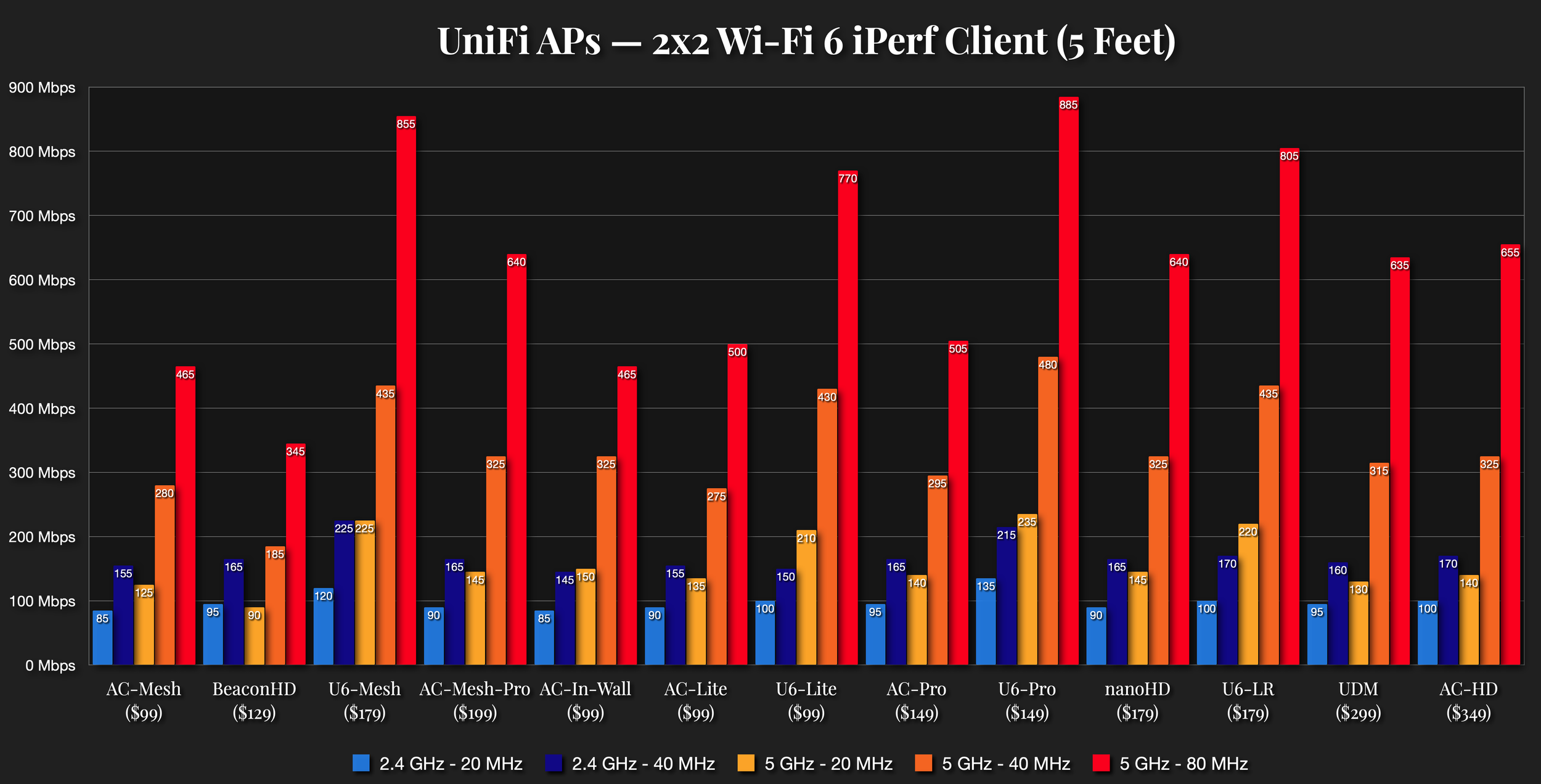

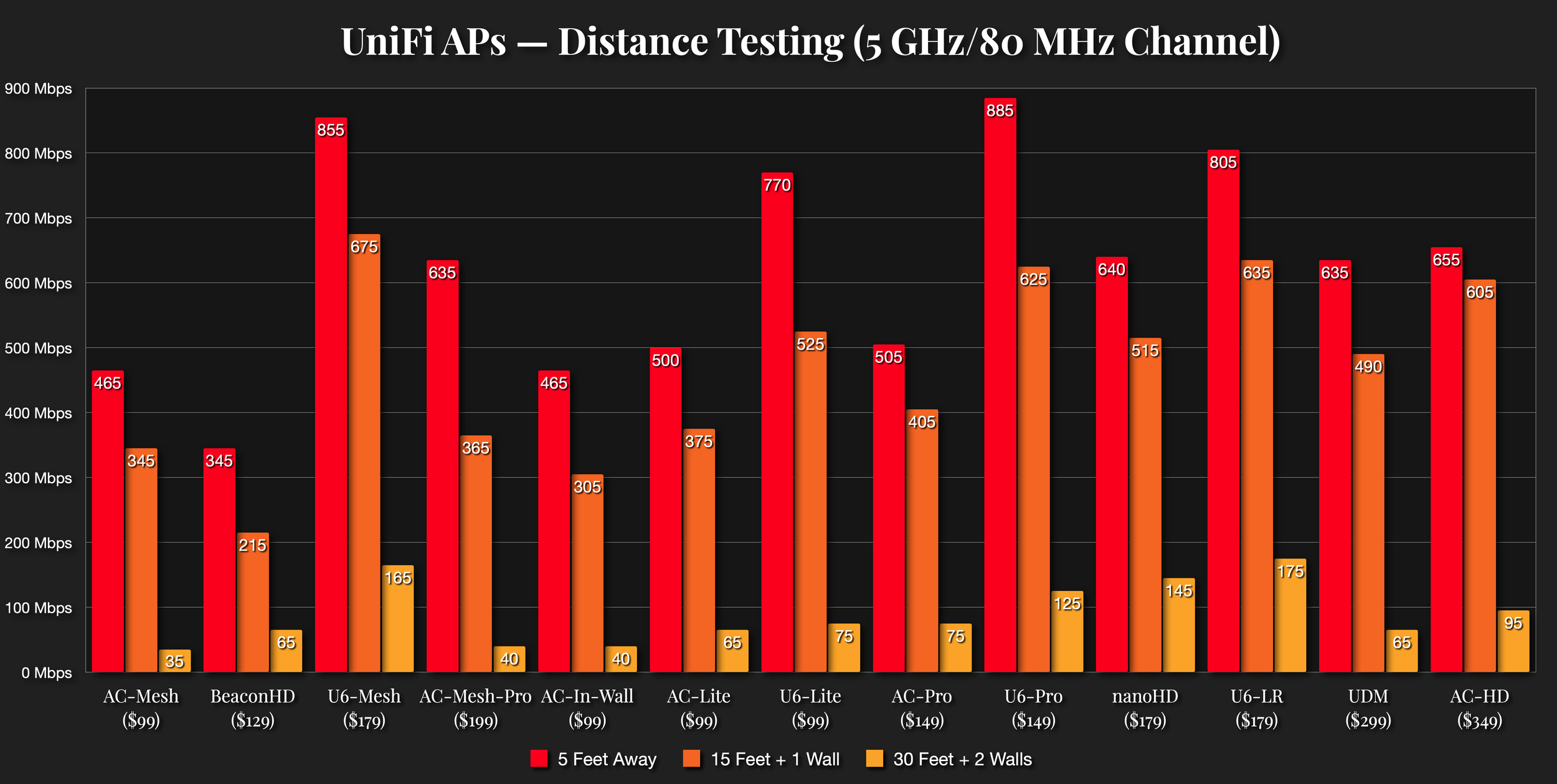

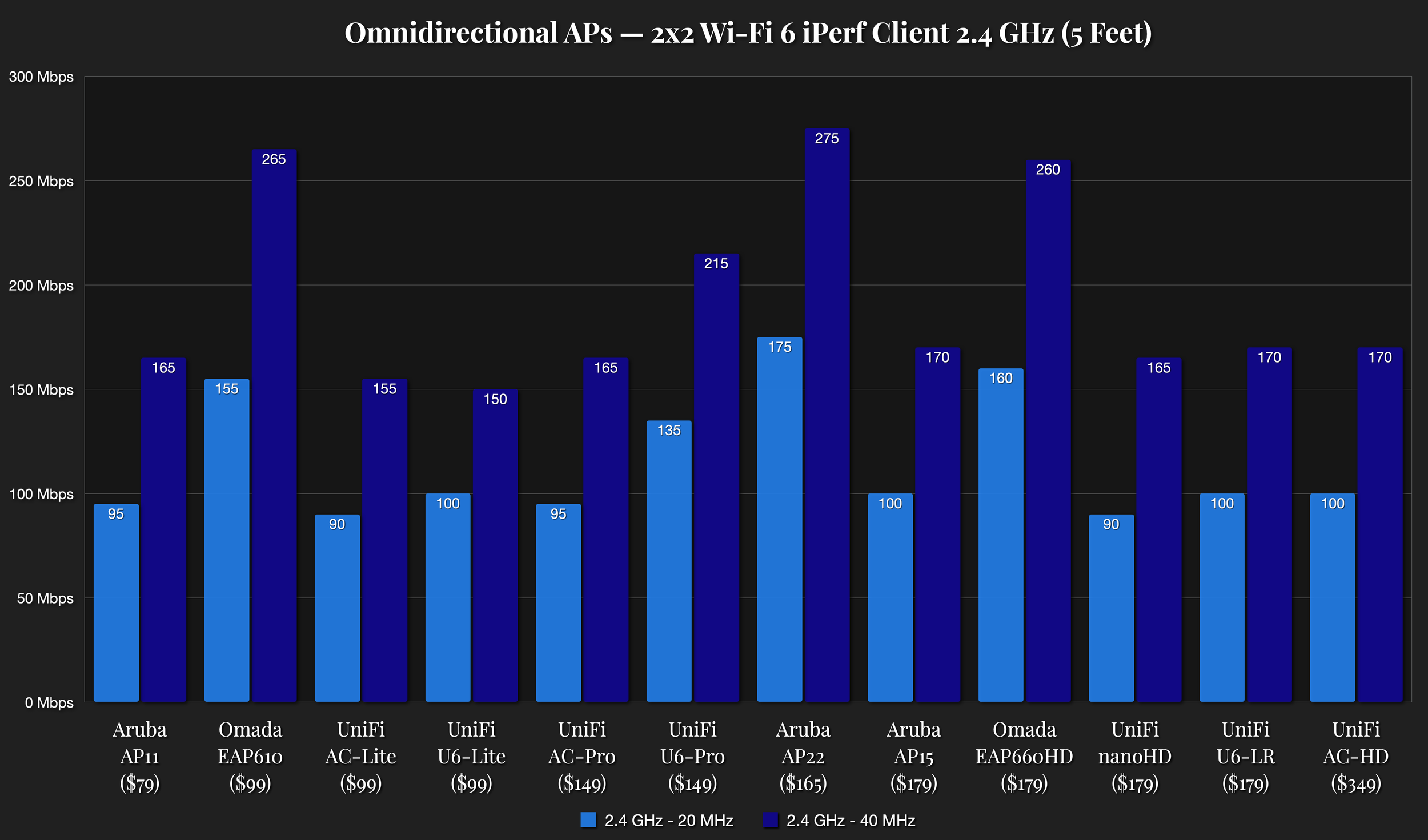







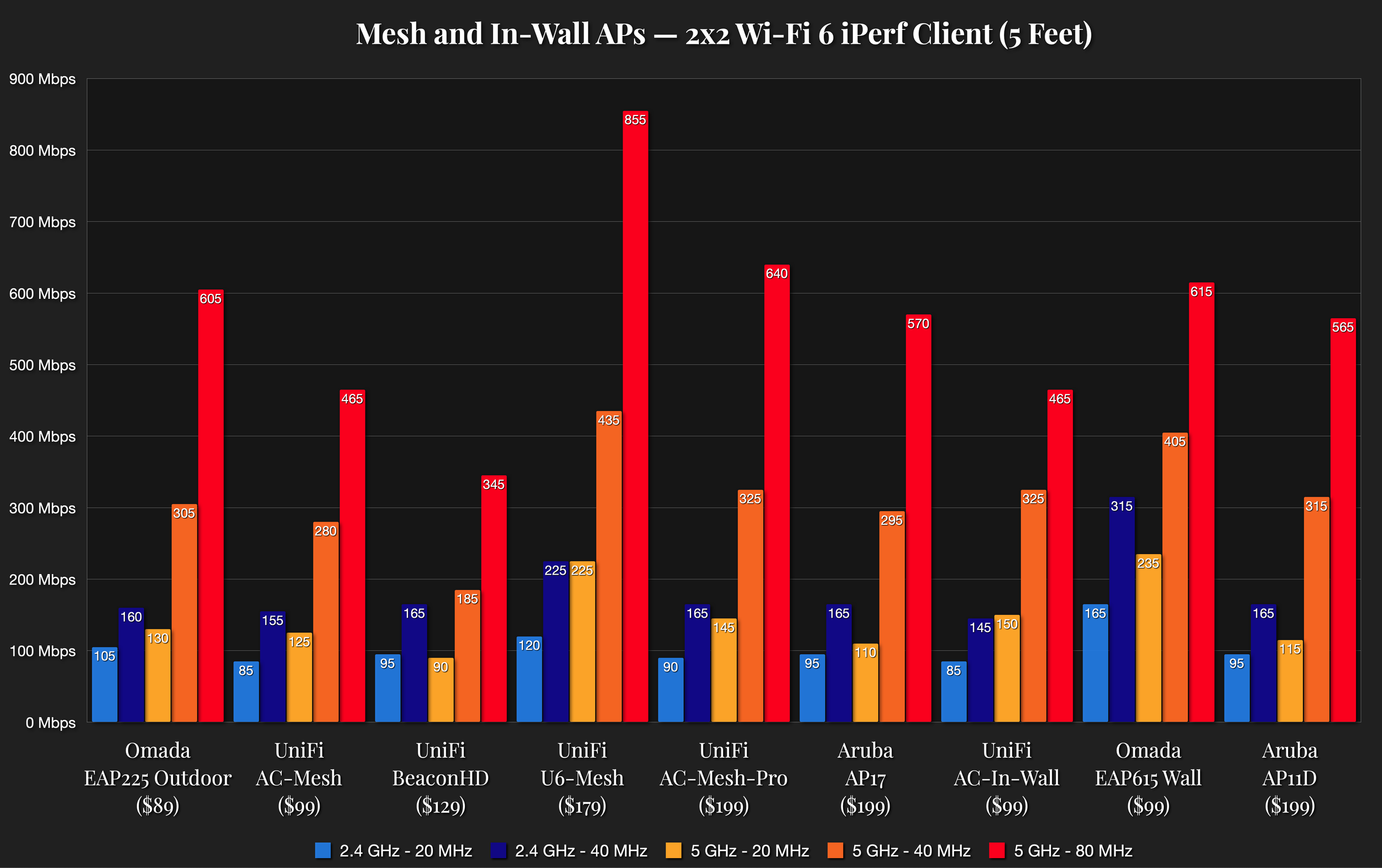
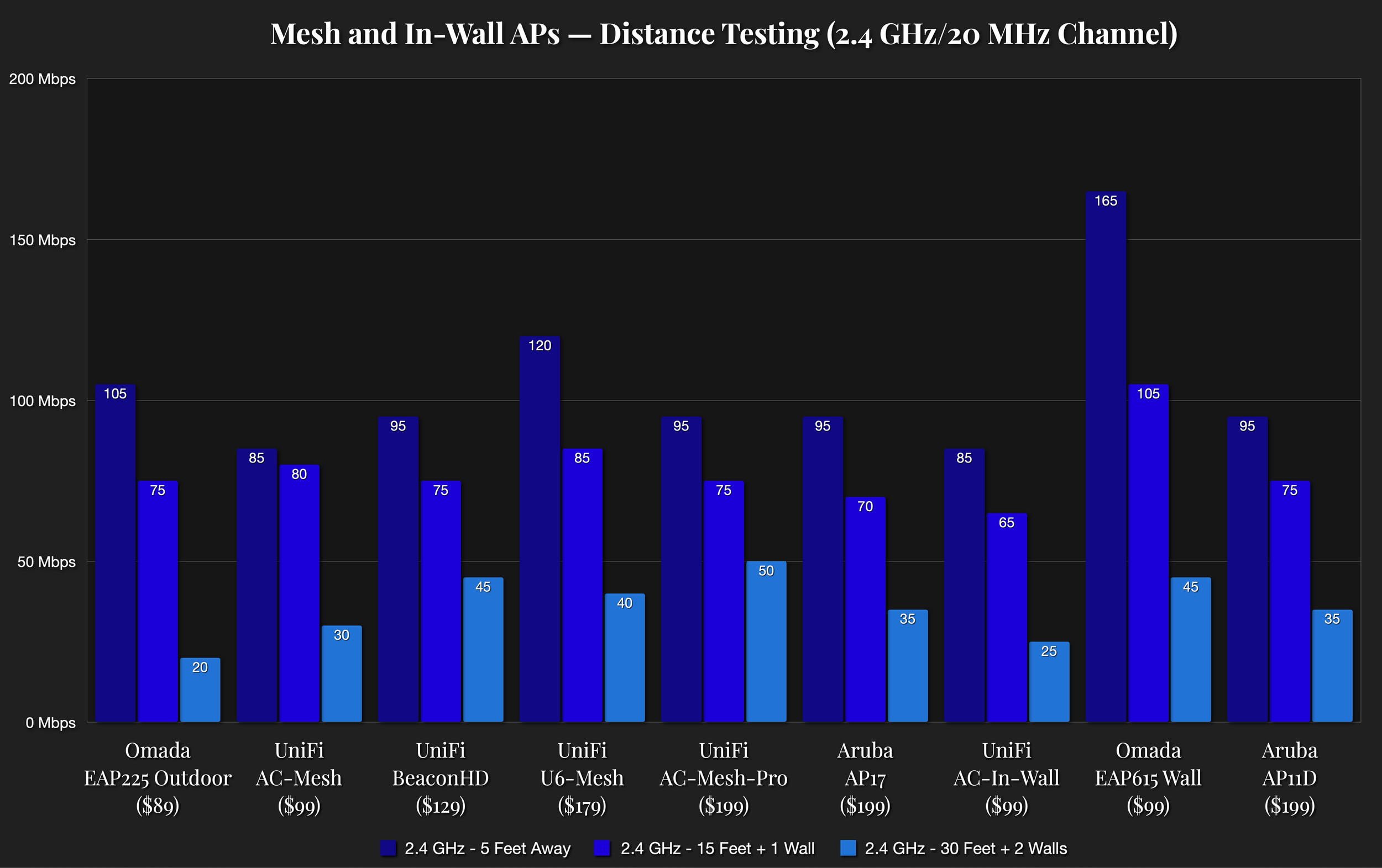
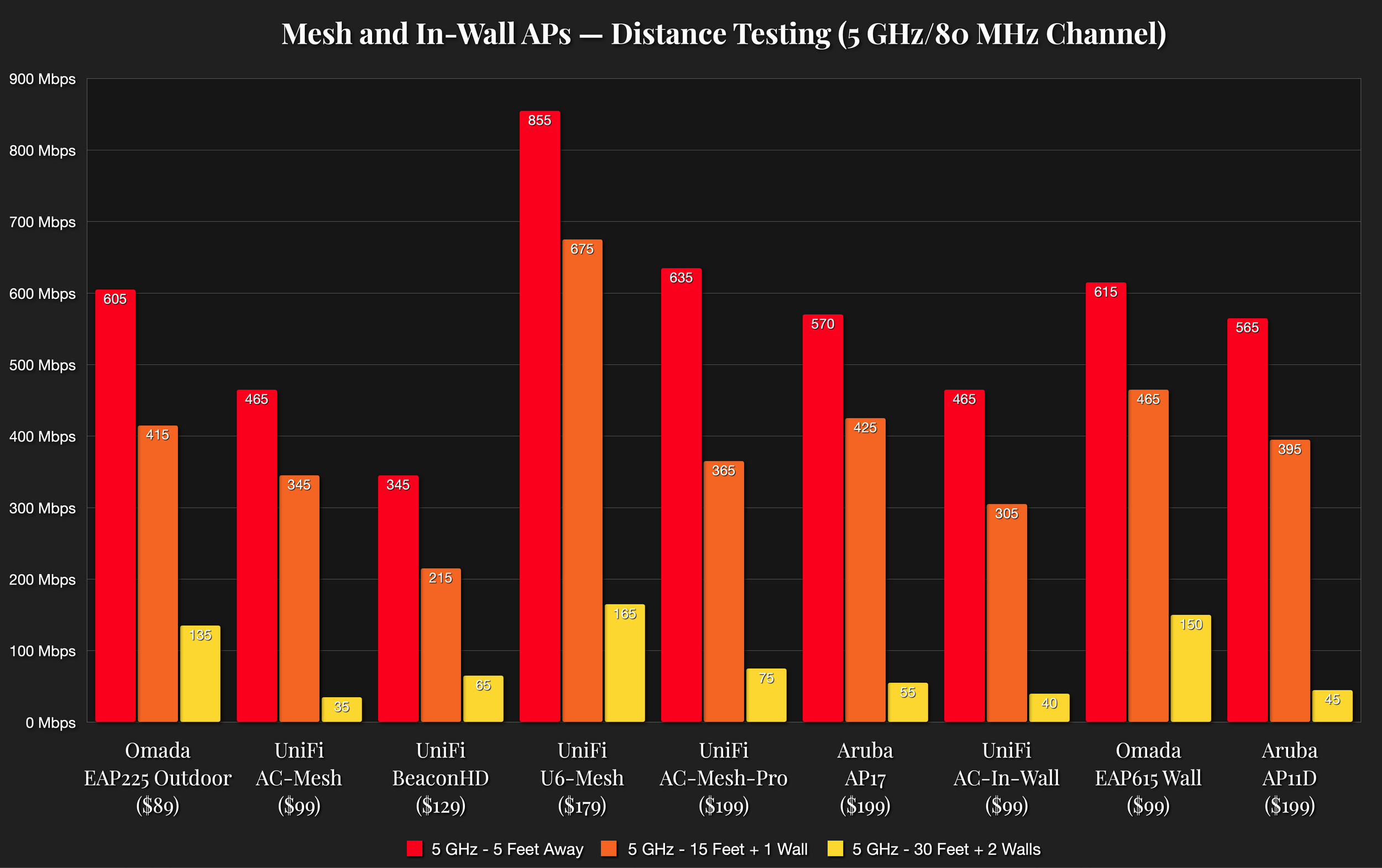


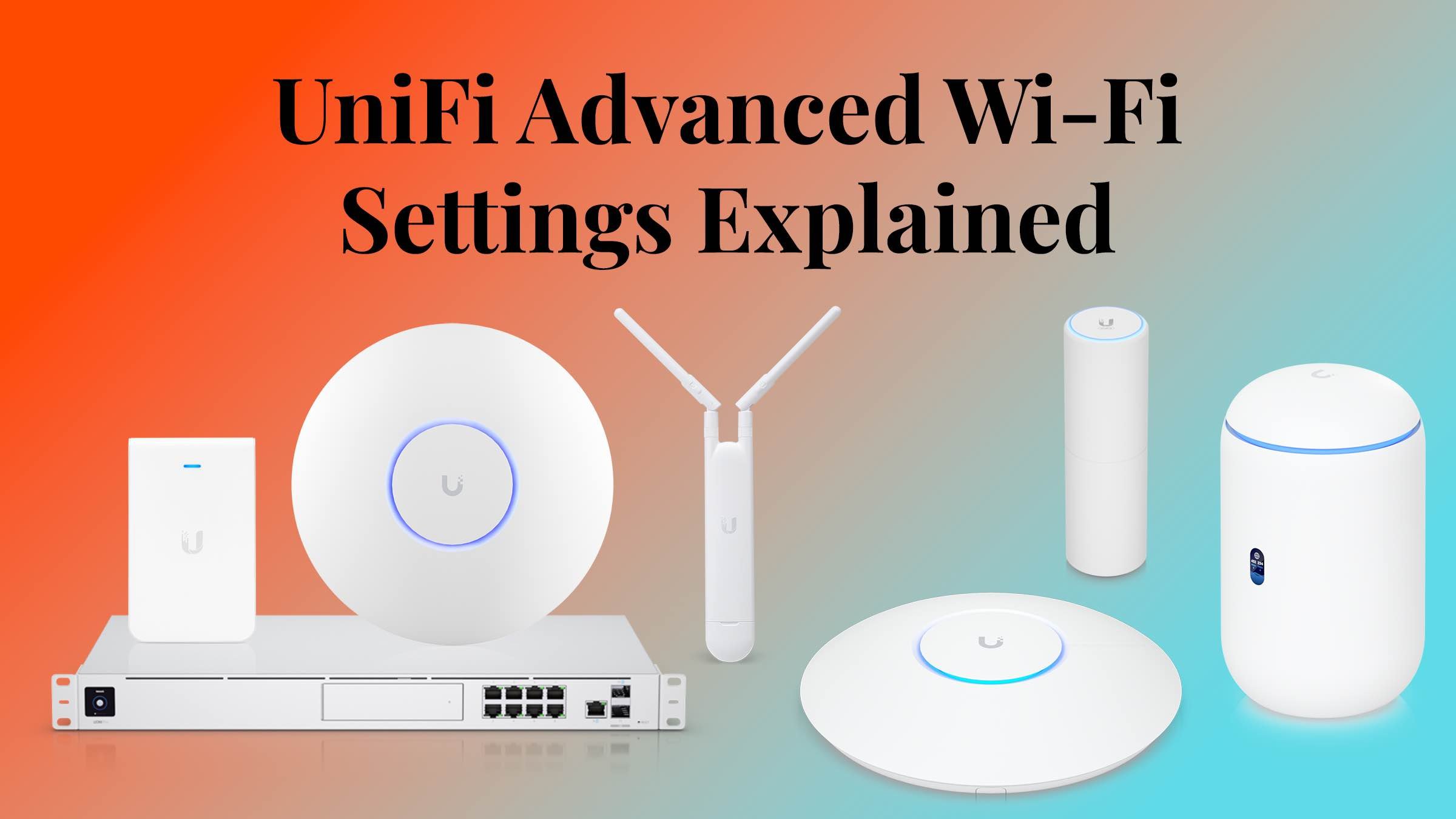

All my charts for comparing Ubiquiti’s models of UniFi Gateways, Consoles, Wireless Access Points, and Switches. Last updated in December 2024 for the Enterprise Fortress Gateway, UXG-Enterprise, Enterprise Campus switches, and E7 Enterprise Wi-Fi 7 access points.